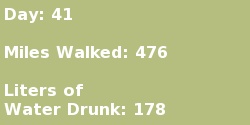Constantino Diaz-Duran is a fellow at the Center for Social Cohesion at Arizona State University. He is chronicling his walk from New York to Los Angeles to celebrate his eligibility for American citizenship. Follow Constantino’s progress.
“This is where my son’s best friend lives,” said Ana, who hosted me my first night in Richmond. “You should come in; it’s an interesting household.”
Interesting was an understatement. It was fantastic, literally. The minute I set foot inside this plain-looking, and rather small, house I felt like Alice falling through the looking glass–transported to a hidden world of fantasy and chaos.
 I couldn’t count how many people there were in the house, but it seemed like dozens. I saw young kids, preteens, teens, guys in their 20s or 30s, a tiny baby, a few middle-aged folks, and a couple of senior citizens. Everyone seemed too busy to take much notice of Ana and me, yet I felt like there were eyes peering from every corner. And some of the people seemed to scurry away when we made eye contact. Adding to this was a soft light that lent the place an air of mystery.
I couldn’t count how many people there were in the house, but it seemed like dozens. I saw young kids, preteens, teens, guys in their 20s or 30s, a tiny baby, a few middle-aged folks, and a couple of senior citizens. Everyone seemed too busy to take much notice of Ana and me, yet I felt like there were eyes peering from every corner. And some of the people seemed to scurry away when we made eye contact. Adding to this was a soft light that lent the place an air of mystery.
On the kitchen bar, in front of a four- or five-year-old boy, sat a big bowl of barbecue ribs and some rice. It smelled delicious. Off to the right, in the living room, a boisterous group of teenagers huddled around a computer. Ana told me their names, and I forgot them instantly. “Now this guy, I don’t know who he is,” she said, pointing at a young boy who seemed fascinated with the utility tool hanging from my belt. “That’s Jayden,” said a man now standing by the kitchen. “Is that a blade? Can I see the blade?” the kid asked.
I repeat: chaos. I didn’t know where I was standing or what in the world was going on.
The man by the kitchen was Chuck. I gathered he was in charge. I was trying to find a polite way to ask “What is this?!” but I had no chance. Next thing I knew, we were in the back yard. There seemed to be dogs everywhere – later I realized there were only four – and all the way back, behind a fish pond, I saw a white gazebo decked out in Christmas lights. The word may seem dramatic, but it was magical. Five or six people of various ethnicities sat there, drinking and chatting. They waved hello.
Again: chaos, fantasy, and a whole lot of “WTF?”
I got the answers to my questions two days later, when I returned to the house during the day.
Chuck and his partner, Jack, own the house. They have six adopted children, and share their home with a number of friends and relatives. People come and go from this house, and the number of dwellers varies by the week, and sometimes by the day. The day I visited, 17 people were set to spend the night there.
The house, which had three bedrooms when they bought it five years ago, now has 10. “Some are as small as something you’d find in New York – if a bed fits, it’s a bedroom.” Chuck said. To convert their small house into a dwelling for dozens, they have gotten creative. They walled off the dining room, for example, and carved two rooms out of the garage.
Over the course of a decade, Chuck, who works at a restaurant, and Jack, who works in construction, have come to administer a sort of sanctuary for people in need of shelter. Four of the children they have adopted are biologically related to Jack. The other two are the children of friends who were unable to care for them.
The kids are close in age. They have two 15-year-olds, two 14-year-olds, an 8-year-old and a 9-year-old. This presents challenges of its own, but the couple strives to provide them a healthy and stable environment. Under their care, the children have flourished, and have been able to stay out of trouble. They are Chuck’s and Jack’s number one priority, and they make that clear to the other people who benefit from their kindness.
The other people have ended up at their house due to various circumstances. There’s John, for example, an old friend who got laid off a couple of months ago, and evicted last week. His son, Jayden, is the kid who wanted to see “the blade” in my utility tool. They’re staying with Chuck and Jack until John is able to get a new job and afford a permanent place for them to live.
 They have also opened their house to undocumented immigrants who Jack has met at construction jobs. “These guys, they can’t get much work anymore,” he said. “They can’t afford to pay a lot in rent, so we let them come here, and if they can’t afford to pay us, then they help out with repairs around the house, cleaning, or gardening.”
They have also opened their house to undocumented immigrants who Jack has met at construction jobs. “These guys, they can’t get much work anymore,” he said. “They can’t afford to pay a lot in rent, so we let them come here, and if they can’t afford to pay us, then they help out with repairs around the house, cleaning, or gardening.”
To help feed all these people, Chuck and Jack have turned their small house into a miniature farm. They have a chicken coop, a garden, and several fruit trees. They grow tomatoes, okra, potatoes, squash, a variety of Vietnamese vegetables, pears, persimmons, apples, peaches, and plums.
I spent a couple of hours chatting with Jack and Chuck about their lives, the challenges they face, and of course, the meaning of being American. I will share their thoughts with you in part two. In the meantime, click here for more pictures.
Be a part of Constantino’s journey.
Follow Constantino on Facebook and Twitter.
See Constantino’s entire route.
*Photo by Constantino Diaz-Duran.




Send A Letter To the Editors